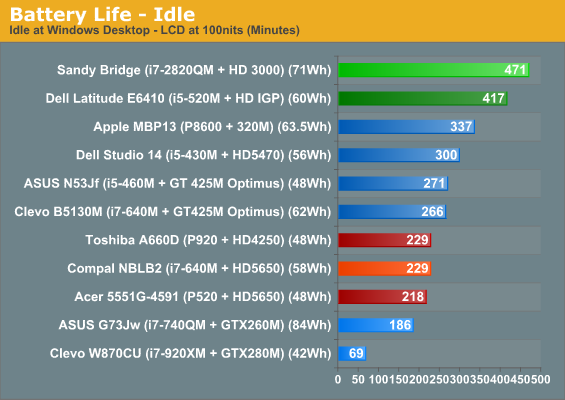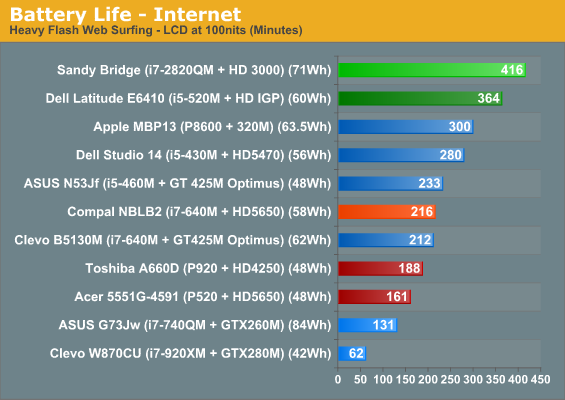Intel’s Sandy Bridge i7-2820QM: Upheaval in the Mobile Landscape
by Jarred Walton on January 3, 2011 12:00 AM EST- Posted in
- Laptops
- Intel
- Sandy Bridge
- Compal
All the Performance, and Good Battery Life As Well!
We’ve just finished showing that CPU and GPU performance has basically more than doubled compared to last year’s Arrandale offerings. That’s great news, but what happens to battery life? We’ve got 35W TDP Arrandale parts compared to a 45W TDP Sandy Bridge quad-core; doesn’t that mean battery life will decrease by around 25%? The answer is happily no; as we’ve point out in the past, TDP isn’t really a useful measurement of power requirements. All the TDP represents in this case is the maximum amount of power Sandy Bridge should draw. So worst-case battery life under full load might drop, but the real question is going to be what happens under typical workloads.
Intel’s use of power gating and variable clock speeds is put to good use, with the result being battery life that is nothing short of exceptional when compared to previous generation products. We’ve seen ULV and Atom netbooks and ultraportables get battery life into the 8+ hour range, but such designs have always required serious compromise in the performance department. SNB certainly won’t beat out Atom for pure battery life, but that doesn’t mean it’s a power hog. Our Compal test system comes with a 71Wh battery, which is larger than what we’ve seen in many 15.6” and smaller designs but still reasonable for a 17.3” chassis. Here are the results of our standard battery life testing.




Yes, those figures are accurate. Best-case, running at 100nits, quad-core Sandy Bridge still lasted nearly eight hours on a single charge! What’s more interesting is that our standard Internet battery life test that loads four pages with Flash ads every sixty seconds still checks in just shy of seven hours. Finally, H.264 playback also comes in at the top of our charts, providing more than four hours of demanding video playback. If 240 minutes of content off your HDD/SSD isn’t enough, we also were able to watch a Blu-ray disc and still get 220 minutes of 35Mbit VLC playback. Wow!
So Sandy Bridge comes out on the top of the above charts, but we didn’t include some of the other long battery life alternatives. Just to put things in perspective, ASUS’ U30JC—with an SSD and an 84Wh battery—has long been our king for matching reasonable performance with long battery life. It managed 588 minutes idle, 476 minutes Internet, and 254 minutes H.264 playback. That’s 25% more idle life, but only 14% better Internet and actually slightly lower H.264 battery life, and you need to factor in the 18% higher capacity battery and 13.3” (versus 17.3”) LCD.
We have to wonder just how small of a form factor manufacturers can manage to cram the quad-core Sandy Bridge into. Idle and low usage power requirements are clearly very good, but with maximum TDP still at 45W the chassis needs to be able to handle the heat. We’d really love to see some 14” designs with quad-core CPUs, and the icing on the cake would be sticking a reasonably fast discrete GPU with graphics switching technology into the case as well. Intel doesn’t have any LV/ULV quad-core parts listed—yet!—so we may have to wait for ultraportable quad-core laptops, but certainly 15.6” designs should be able to combine SNB with reasonably fast Optimus GPUs to provide an optimal blend of performance and mobility.










66 Comments
View All Comments
JarredWalton - Monday, January 3, 2011 - link
All of the mobile chips list AES/TXT/vPRO support, unlike the desktop chips. They also all support Quick Sync and have 12 EUs.DesktopMan - Monday, January 3, 2011 - link
What about virtualization? Not sure why you are mentioning vPro, the requirement for vPro is usually the chipset, in this case QM67.JarredWalton - Monday, January 3, 2011 - link
They don't specifically break out VT-d and VT-x on the mobile products; all the slides state is that the mobile products support virtualization. On the desktop slide, they have a line saying "vPro/TXT/VT-d/SIPP" but on mobile slides the line says "AES/TXT/vPro". There's a second line for both desktops and mobile chips that just says "Intel Virtualization Technology" but it's not too useful since it just says "Yes" on every single Sandy Bridge CPU listed. :-\Hrel - Monday, January 3, 2011 - link
finally gaming on IG. Sooo, when do new Nvidia Gpu's come out for laptops?JarredWalton - Monday, January 3, 2011 - link
Check back on Jan 6. :-pmobomonster - Monday, January 3, 2011 - link
AMD is toast. Those are blistering performance numbers that even I did not expect. Incredible that it manages near 30 fps in several games at medium detail settings.The lower power dual core Sandy Bridge models will really put the squeeze on AMD. Even a regular 2520M will give AMD's Brazos a lot of trouble.
tipoo - Monday, January 3, 2011 - link
Bah, AMD has been toast for years now, if they really were, they would be buttered and eaten already.yes, horrible metaphor is horrible.
Kangal - Monday, January 3, 2011 - link
I'm a tech enthusiast especially in the portable device scene, and I always nit-pick things.Which is the reason why I own the Acer 4810TG.
The Core i7 640-UM would be my favourite processor, until I saw this.
The successor, 2657M, seems to have (theoretical) performance improvement of 19% and battery saving of 6%, which is very amazing.
From pure guestimation, this is ~200% (or slightly more) performance of the SU7300 at the same battery life. Whoa!
This would mean new ultra-portable devices (less than 14" and over 6 hours battery life).
If this gets partnered with the ATi 5650 (or its successor), this will bring serious gaming potential to ultra-portable devices *drools*
------
BUT, I wish they could add another chip on that (ULV) list.
The exact same thing as the i7 2657M but tossing the dual-core setup for a single core, if it meant they could increase the down the battery life by 70%. (Name it the 1357M?)
I mean, how about real 10 hours battery life (6 cell) on something about as fast as the SU7300 ??
Something like that (Core i7 1357M?) could make Windows7 tablets a more viable option.
davepermen - Monday, January 3, 2011 - link
I'd prefer a dualcore with 1ghz, or even 800mhz. as it could still clock to 2ghz or so, it would be fast when needed, but very battery saving else.if intel would go down further, it would most likely by now kill atom in the netbook and tablet area. and in the phone area, atom isn't there yet.
personally, i hate atom for being in the way. ultralow core i1 would be AWESOME.
JarredWalton - Monday, January 3, 2011 - link
SpeedStep lets all the SNB processors (mobile versions at least) run at 800MHz when they're not doing anything else. So you've already got what you're asking for, more or less.